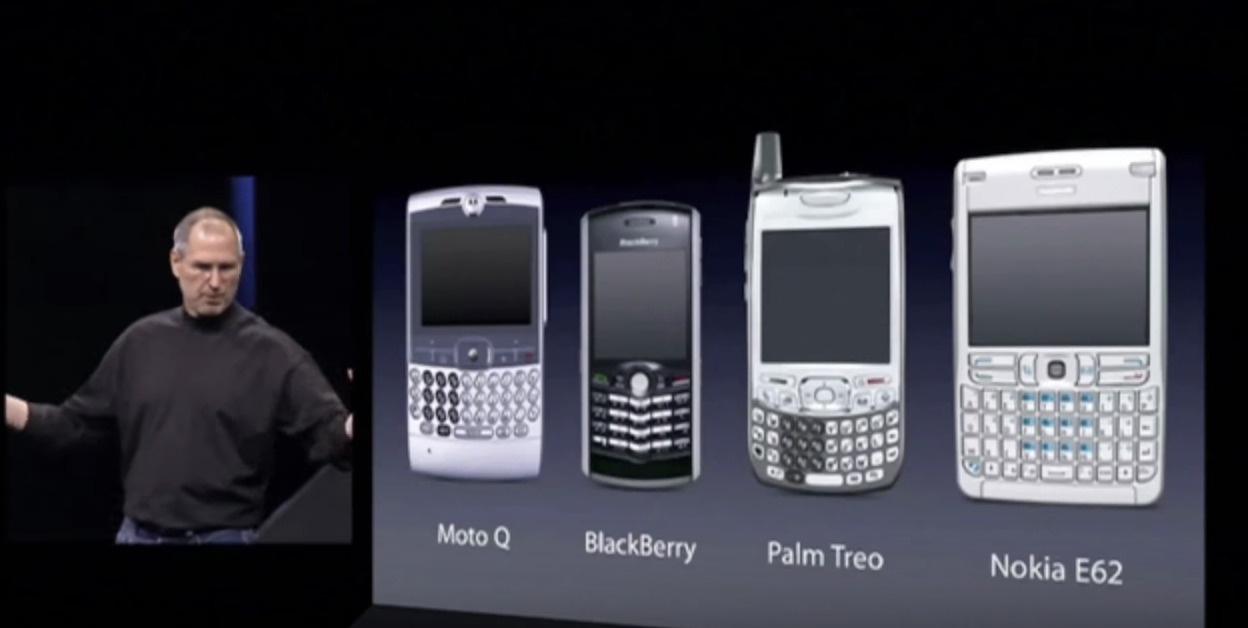Introduction: A Paradigm Shift in Technology
On June 29, 2007, the world witnessed a technological revolution that would reshape the way we communicate, work, and liveThe original iPhone, released by Apple, was a device that defied expectations and set the stage for a new era of mobile innovation.
While it may have lacked the bells and whistles of today’s iPhones, its impact was profound, shaping the course of technology for years to come.
In this article, we’ll take a deep dive into the details of the first-generation iPhone’s features, the challenges it faced, and the enduring legacy it left behind.
Project Purple
The concept of an Apple phone originated from Jean-Marie Hullot, a software engineer who had previously worked at NextStep and MacOS.
Initially, Steve Jobs, the CEO of Apple, was not inclined towards the idea of creating a phone. However, Hullot, based in Apple France, managed to persuade Jobs over time.
Apple initially formed the team in Paris, but it wasn’t until later that the project gained serious traction. Apple requested French engineers to relocate to the US, but Hullot declined and, along with his team, left the company.
Another engineer named Henri Lamiraux took over the project, with Scott Forstall, to develop the iPhone’s software. The genesis of the iPhone’s development traces back to a conflict between Steve Jobs and his brother-in-law at Microsoft.
Jean-Marie Hullot, a prominent engineer at Apple France, played a key role in convincing Jobs to explore the idea. The project was initiated under the codename “Project Purple” and involved the collaboration of hardware engineer Tony Fadell, software engineer Scott Forstall, and design engineer Jonathan Ive.
The Jobs Effect
While initially competing teams led by Fadell and Forstall were working on different ideas, Jobs began to explore the potential of touchscreen devices and tablet computers.
This exploration eventually led to the creation of the iPad. Jobs envisioned a touch-screen device, much like the previous touch-screen device developed by Apple, the Newton MessagePad.
Apple’s Chief Design Officer, Jonathan Ive, crafted the iPhone’s distinctive form factor, characterized by its almost entirely screen-based interface.
Jobs believed that tablet PCs and traditional PDAs were not the right market for Apple to enter, despite requests from consumers.
After the success of the iPod, Jobs recognized the growing overlap between mobile phones and music players.
He foresaw that consumers would prefer a single device that combined these functionalities. This insight prompted Apple to venture into the wireless and mobile phone market to safeguard the iPod’s dominance.
Recognizing the continuous integration of features into cell phones and mobile devices, Jobs foresaw a potential threat to the dominance of the iPod as a premier music player.
Given that the iPod accounted for a substantial 48% of Apple’s total revenue at the beginning of 2007, Jobs understood the importance of safeguarding its position in the market.
wireless technology
This realization prompted him to explore the realm of wireless technology.
Rather than directing efforts towards the development of a follow-up to their existing Newton PDA, Jobs strategically shifted Apple’s focus towards the iPod.
In parallel, he orchestrated the creation of iTunes software, which played a pivotal role in synchronizing content with iPod devices.
This move to prioritize the iPod and the concurrent development of iTunes marked a strategic decision by Jobs to fortify Apple’s position in the market amid the evolving landscape of mobile technology.
Apple launched iTunes in January 2001, setting the foundation for seamlessly integrating content with their iconic music player.
Several technological advancements paved the way for the creation of the iPhone, including efficient lithium-ion batteries, multi-touch screens, energy-efficient yet powerful CPUs, mobile phone networks, and web browsers.
Apple’s collaboration with Corning in 2005 led to the development of Gorilla Glass, a thin, flexible, and transparent material that could address the issue of scratches on phone screens caused by metal keys.
Read more: Steve Jobs: The Man Who Changed Semiconductors Without Even Trying
The evolution of a technical miracle
In 2004, Apple initiated the creation of the iPhone beta, a preliminary version aimed at testing the device’s functionalities and capabilities.
This beta iteration allowed Apple to refine and enhance the phone’s features before unveiling the final product.
While technically constituting the first iteration of the iPhone, the company never intended the beta version for public release. Therefore, it does not hold the distinction of being the inaugural iPhone.
In a bid to circumvent reliance on cellular carriers, Steve Jobs sought collaboration with Motorola. This partnership culminated in the development of the Motorola ROKR E1, introduced on September 7, 2005, as the first mobile phone integrated with iTunes.
However, dissatisfaction arose due to limitations imposed by the ROKR E1’s firmware, including storage constraints and the inability to wirelessly download iTunes Music Store purchases.
These setbacks led Apple to decide on developing its own phone, one that seamlessly merged the musical capabilities of the iPod with the functionality of a smartphone.
The compromise of collaborating with an external designer, Motorola, hindered Apple’s vision for the phone they aspired to create.
Consequently, Apple terminated support for the ROKR in September 2006 and entered into a partnership with AT&T (then known as Cingular). Subsequently, a version of iTunes was released, containing references to an enigmatic mobile phone with the ability to display images and videos.
This marked the inception of the first iPhone, later known as iPhone 2G.
On January 9, 2007, during the Macworld convention, Steve Jobs officially unveiled the inaugural iPhone, drawing significant media attention.
Read more: Follow us on LinkedIn for everything around Semiconductors & AI
Conference
At Apple’s Worldwide Developers Conference on June 11, 2007, it was revealed that the iPhone would support third-party applications via the Safari engine.
Even prior to the iPhone’s launch, web-based applications began to emerge, with the first being OneTrip, designed to assist users in managing their shopping lists.
The culmination of these developments led to the release of the first iPhone on June 29, 2007. Subsequently, in the same year, the iPod Touch, featuring an iPhone-style touchscreen interface, was introduced.
The trajectory continued with the launch of the iPad in 2010, completing the lineage of devices that transformed the way we interact with technology.
A Radical Departure: Redefining Mobile Design
The first-generation iPhone’s design was a departure from anything the world had seen before. Its compact dimensions of 4.5 inches by 2.4 inches made it seem small by today’s standards, but it was a giant leap from the phones of the time.
The introduction of a touch-centric interface, devoid of physical buttons, was a game-changer. Steve Jobs famously declared that they were replacing “buttons with a giant screen,” a bold move that would forever change the way we interact with technology.
Overcoming Conventional Limitations: Touchscreen Innovation
Before the iPhone, the smartphone market was dominated by devices with physical keyboards and navigation buttons.
The iPhone’s revolutionary touchscreen interface shattered these norms and redefined user interaction.
While other smartphones had resistive touchscreens that required stylus input, the iPhone introduced a capacitive touchscreen that responded to the human touch.
This innovation not only made interactions more intuitive but also laid the foundation for the proliferation of touch-enabled devices across industries.
Facing Skepticism: Disrupting the Status Quo
The iPhone’s launch wasn’t met with unanimous enthusiasm. Industry leaders and experts expressed doubts about its potential to succeed.
Then-Microsoft CEO Steve Ballmer famously underestimated the iPhone’s impact, predicting it would achieve only a small market share due to its higher price point.
BlackBerry’s executives were similarly blindsided by the iPhone’s capabilities, revealing a failure to anticipate the seismic shift that was about to take place.
The skepticism extended to the media, with some outlets predicting its failure due to its unconventional design and lack of certain features.
The Unveiling: Macworld 2007 Keynote
The iPhone’s introduction at the 2007 Macworld event was a defining moment in technology history.
Steve Jobs, Apple’s iconic co-founder, took to the stage with palpable excitement, unveiling a device that combined an iPod, a phone, and an internet communication device.
He boldly compared the iPhone to its contemporaries, criticizing their reliance on physical keyboards and buttons. Jobs’ passion and conviction resonated, capturing the audience’s attention and setting the stage for a paradigm shift.
Commercial Release and Initial Impact
The original iPhone hit the market on June 29, 2007, offering models with storage capacities of 4GB and 8GB, priced at $499 and $599, respectively.
It ran on iPhone OS 1, now known as iOS, and included a range of native apps. Despite limitations such as the lack of third-party applications, the device garnered praise for its sleek design, intuitive interface, and potential for future innovation.
Catalyst for Change: Shaping the Smartphone Landscape
The iPhone’s release marked the beginning of a new era in mobile technology. Subsequent iterations, including the iPhone 3G with the introduction of the App Store, solidified the iPhone’s status as a technological game-changer.
The combination of Apple’s dedication to innovation and the allure of third-party app development led to exponential growth in sales and cemented Apple’s dominance in the smartphone market.
Enduring Legacy: Pioneering the Future
The original iPhone’s legacy extends far beyond its initial sales figures. Its introduction laid the groundwork for the modern smartphone landscape, inspiring competitors to rethink their approach to design and functionality.
The revolutionary touchscreen, once a novelty, has become an industry standard. Moreover, the iPhone’s influence expanded to other Apple devices like the iPod Touch and the iPad.
The iPhone remains the cornerstone of Apple’s success, generating staggering revenue and shaping the company’s identity as a technological trailblazer.
Conclusion: A Glimpse into the Past, a Vision for the Future
The first-generation iPhone may have been modest in comparison to its successors, but its impact was colossal.
It defied skeptics, shattered conventions, and set a trajectory for innovation that continues to shape our digital lives.
As we reflect on its journey from a small device with a giant screen to a global phenomenon, we recognize the indelible mark it left on technology and culture.
The original iPhone stands as a testament to the power of visionary thinking, forever altering the way we interact with the world around us.








